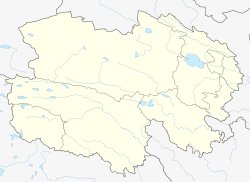Tongren
同仁市 · ཐུང་རིན་གྲོང་ཁྱེར། Rebgong | |
|---|---|
 Tongren from above | |
 Tongren (light red) within Huangnan Prefecture (yellow) and Qinghai | |
| Coordinates (Tongren County government): 35°30′58″N 102°01′06″E / 35.5161°N 102.0183°E | |
| Country | China |
| Province | Qinghai |
| Autonomous prefecture | Huangnan |
| Municipal seat | Longwu (Rongwo) |
| Area | |
| • Total | 3,275 km2 (1,264 sq mi) |
| Elevation | 2,480 m (8,140 ft) |
| Population (2020)[1] | |
| • Total | 101,519 |
| • Density | 31/km2 (80/sq mi) |
| Time zone | UTC+8 (China Standard) |
| Postal code | 811399 |
| Area code | 0973 |
| Website | www |
| Tongren, Qinghai | |||||||
|---|---|---|---|---|---|---|---|
| Chinese name | |||||||
| Chinese | 同仁市 | ||||||
| |||||||
| Tibetan name | |||||||
| Tibetan | ཐུན་རིན་གྲོང་ཁྱེར། or རེབ་གོང་གྲོང་ཁྱེར། | ||||||
| |||||||
Tongren (Tibetan: ཐུན་རིན་, Wylie: thun rin; Chinese: 同仁; pinyin: Tóngrén), known to Tibetans as Rebgong (Tibetan: རེབ་གོང་, རེབ་ཀོང་ or རེབ་སྐོང་)[2] in the historic region of Amdo, is the capital and second smallest administrative subdivision by area within Huangnan Tibetan Autonomous Prefecture in Qinghai, China. The city has an area of 3465 square kilometers and a population of ~80,000 (2002), 75% Tibetan. The economy of the city includes agriculture and aluminium mining.
The city has a number of Tibetan Buddhist temples and gompas, including the large and significant Rongwo Monastery of the Gelug school. It is known as a center of thangka painting. Regong arts were named on the UNESCO Intangible Cultural Heritage Lists in 2009.
In October, 2010 there were reports of large demonstrations in Tongren by Tibetan students who reportedly shouted the slogans, “equality of ethnic groups” and “freedom of language."[3]
- ^ "黄南州第七次全国人口普查公报(第二号)——县级常住人口情况" (in Chinese). Government of Huangnan Prefecture. 2021-07-01.
- ^ "China Adds to Security Forces in Tibet Amid Calls for a Boycott" article by Edward Wong in The New York Times Feb. 18, 2009, accessed October 21, 2010
- ^ "China: Tibetan Students March To Protest Education Policies" article by Edward Wong in The New York Times October 21, 2010, accessed October 21, 2010
